The Methyl fluoride (CH3F) features a central carbon (C) atom with 4 valence electrons, bonded to three hydrogen (H) atoms and one fluorine (F) atom. Each hydrogen contributes 1 electron and fluorine contributes 7, totaling 8 bonding electrons. The Lewis structure displays three C-H bonds and one C-F bond, with no lone pairs on carbon. The molecule has a tetrahedral geometry with bond angles around 109.5°. The C-F bond is highly polar due to the significant electronegativity difference (C: 2.55, F: 3.98), contributing to the molecule’s physical and chemical properties.
Understanding the Basics
In this section, we will delve into the fundamental concepts of molecular geometry and chemical bonding, focusing specifically on the molecule CH3F. We will explore topics such as valence electrons, Lewis dot structures, the octet rule, lone pairs, and formal charge. By understanding these basics, we can gain insights into the structure and properties of CH3F.
CH3F Valence Electrons
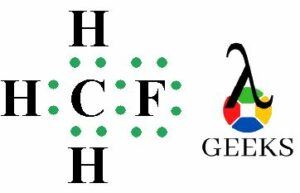
Valence electrons are the outermost electrons in an atom that participate in chemical bonding. To determine the number of valence electrons in CH3F, we need to consider the valence electron configuration of each atom. Carbon (C) has 4 valence electrons, hydrogen (H) has 1 valence electron, and fluorine (F) has 7 valence electrons. Since there are 3 hydrogen atoms and 1 fluorine atom in CH3F, the total number of valence electrons is:
(4 valence electrons for carbon) + (3 valence electrons for hydrogen) + (7 valence electrons for fluorine) = 14 valence electrons
CH3F Lewis Structure Octet Rule
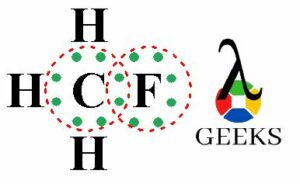
The Lewis dot structure is a visual representation of the valence electrons in a molecule. It helps us understand the arrangement of atoms and the sharing of electrons. According to the octet rule, atoms tend to gain, lose, or share electrons to achieve a stable electron configuration with 8 electrons in their outermost shell (except for hydrogen, which aims for 2 electrons).
In the case of CH3F, carbon (C) is the central atom. It forms single bonds with three hydrogen atoms (H) and a single bond with a fluorine atom (F). Each bond consists of 2 electrons, resulting in a total of 8 electrons around carbon, satisfying the octet rule. The Lewis structure of CH3F can be represented as:
H F
| |
C - H - H
CH3F Lewis Structure Lone Pairs
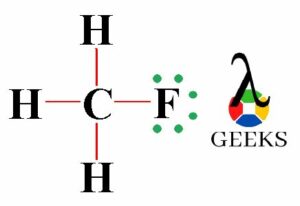
Lone pairs are pairs of valence electrons that are not involved in bonding. In CH3F, the fluorine atom has 3 lone pairs of electrons. These lone pairs are not shared with any other atom but are localized around the fluorine atom. The presence of lone pairs affects the overall shape and polarity of the molecule.
CH3F Lewis Structure Formal Charge
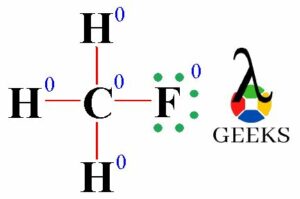
Formal charge is a concept used to determine the distribution of electrons in a molecule. It helps us assess the stability and relative importance of different resonance structures. To calculate the formal charge of an atom, we compare the number of valence electrons in the free atom to the number of electrons assigned to the atom in the Lewis structure.
In CH3F, the formal charge of each atom can be calculated as follows:
Formal charge of carbon (C) = (number of valence electrons in free atom) – (number of lone pair electrons) – (number of shared electrons)
Formal charge of hydrogen (H) = (number of valence electrons in free atom) – (number of shared electrons)
Formal charge of fluorine (F) = (number of valence electrons in free atom) – (number of lone pair electrons) – (number of shared electrons)
By calculating the formal charges, we can determine the most stable resonance structure for CH3F.
Delving Deeper into CH3F Lewis Structure
Fluoromethane (CH3F) is a molecule that consists of one carbon atom (C), three hydrogen atoms (H), and one fluorine atom (F). Understanding the Lewis structure of CH3F is crucial in comprehending its molecular geometry and chemical properties.
How to Draw CH3F Lewis Structure
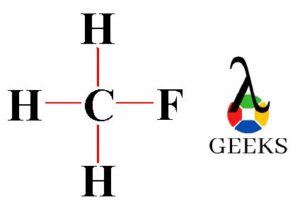
To draw the Lewis structure of CH3F, we need to follow a few steps. First, we determine the total number of valence electrons in the molecule. Carbon contributes four valence electrons, hydrogen contributes one valence electron each, and fluorine contributes seven valence electrons. Adding them up, we get a total of 14 valence electrons.
Next, we arrange the atoms in the molecule. Carbon is the central atom, surrounded by three hydrogen atoms and one fluorine atom. The carbon atom forms single bonds with all three hydrogen atoms and one bond with the fluorine atom.
To distribute the remaining valence electrons, we place them as lone pairs around the atoms. Carbon has no lone pairs, while fluorine has three lone pairs. Each hydrogen atom has one lone pair. By doing this, we complete the octet rule for all atoms, ensuring they have a stable electron configuration.
CH3F Lewis Structure Resonance
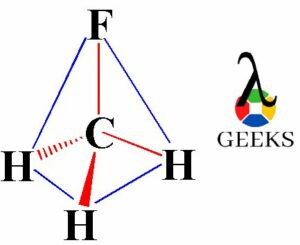
In the Lewis structure of CH3F, there are no resonance structures. Resonance structures occur when there are multiple ways to arrange the electrons in a molecule without changing the positions of the atoms. However, in CH3F, the arrangement of atoms and electrons is fixed, and there is no possibility for resonance.
CH3F Lewis Structure Shape
The molecular geometry of CH3F is tetrahedral. The carbon atom is at the center, with the three hydrogen atoms and one fluorine atom arranged around it. The tetrahedral shape arises due to the arrangement of the four bonding pairs of electrons around the central carbon atom. This geometry results in a symmetric distribution of electron density, making CH3F a nonpolar molecule.
CH3F Lewis Structure Angle
The bond angles in CH3F are approximately 109.5 degrees. This angle is characteristic of a tetrahedral geometry, where the four bonding pairs of electrons are arranged as far apart from each other as possible. The bond angles in CH3F are close to the ideal tetrahedral angle due to the repulsion between the electron pairs.
CH3F Hybridization and Solubility
Understanding CH3F Hybridization
When it comes to understanding the hybridization of CH3F, we need to consider its molecular geometry, Lewis dot structure, valence electrons, and chemical bonding. CH3F, also known as fluoromethane, consists of one carbon atom (C) bonded to three hydrogen atoms (H) and one fluorine atom (F). The molecular formula of CH3F suggests that it follows the octet rule, where the central carbon atom forms four covalent bonds to achieve a stable electron configuration.
To determine the hybridization of CH3F, we can use the molecular orbital theory and the concept of electron pair geometry. The carbon atom in CH3F undergoes sp3 hybridization, which means that it forms four sp3 hybrid orbitals by mixing one 2s orbital and three 2p orbitals. These hybrid orbitals then overlap with the orbitals of the hydrogen and fluorine atoms to form four sigma (σ) bonds.
The hybridization of CH3F results in a tetrahedral electron pair geometry around the central carbon atom. This means that the four bonding pairs of electrons are arranged in a three-dimensional tetrahedral shape, with bond angles of approximately 109.5 degrees. The molecular geometry of CH3F is also tetrahedral, as the four atoms bonded to the central carbon atom are arranged symmetrically around it.
CH3F Solubility
Now let’s shift our focus to the solubility of CH3F. Solubility refers to the ability of a substance to dissolve in a particular solvent. In the case of CH3F, its solubility depends on the nature of the solvent and the polarity of the molecule.
CH3F is a polar molecule due to the difference in electronegativity between carbon and fluorine atoms. The fluorine atom is more electronegative, causing a partial negative charge on the fluorine atom and a partial positive charge on the carbon atom. This polarity leads to the formation of dipole-dipole interactions between CH3F molecules.
In general, polar molecules like CH3F tend to be soluble in polar solvents such as water. This is because the polar solvent molecules can interact with the polar CH3F molecules through dipole-dipole interactions, allowing them to dissolve. However, CH3F has limited solubility in water due to its relatively low molecular weight and the presence of nonpolar carbon-hydrogen bonds.
On the other hand, CH3F is more soluble in nonpolar solvents such as organic solvents. Nonpolar solvents lack the ability to form strong dipole-dipole interactions with CH3F molecules. Therefore, the nonpolar nature of the solvent allows CH3F to dissolve more readily.
CH3F Ionic or Covalent?
Is CH3F Ionic?
When determining whether a compound like CH3F is ionic or covalent, we need to consider its molecular geometry, Lewis dot structure, valence electrons, and chemical bonding. In the case of CH3F, it is a covalent compound rather than an ionic compound.
Why CH3F is not Ionic?
Ionic compounds are formed when there is a transfer of electrons between atoms, resulting in the formation of ions. However, in the case of CH3F, there is no transfer of electrons between the carbon and fluorine atoms. Instead, they share electrons through covalent bonding.
How CH3F is not Ionic?
To understand why CH3F is not ionic, let’s take a closer look at its molecular structure. CH3F, also known as fluoromethane, consists of one carbon atom (C), three hydrogen atoms (H), and one fluorine atom (F). The Lewis dot structure of CH3F shows that each hydrogen atom shares one electron with the carbon atom, while the fluorine atom shares one electron with the carbon atom as well. This sharing of electrons forms covalent bonds.
In terms of molecular geometry, CH3F adopts a tetrahedral shape. The central carbon atom is bonded to four other atoms, resulting in a tetrahedral electron pair geometry. This arrangement is achieved through the process of hybridization, where the carbon atom’s orbitals mix to form new hybrid orbitals.
The covalent bonds in CH3F are formed based on the octet rule, which states that atoms tend to gain, lose, or share electrons to achieve a stable electron configuration with eight valence electrons. In the case of CH3F, each atom has achieved an octet by sharing electrons.
According to the VSEPR theory (Valence Shell Electron Pair Repulsion theory), the lone pair electrons on the fluorine atom cause a slight distortion in the molecular geometry, resulting in a slightly polar molecule. However, overall, CH3F is considered a nonpolar molecule due to the symmetrical arrangement of the atoms.
CH3F Acidity or Basicity
Is CH3F Acidic or Basic?
When it comes to determining the acidity or basicity of a compound, we need to consider its chemical properties and structure. In the case of CH3F (fluoromethane), it is considered to be a weak acid.
Why CH3F is Acidic?
The acidity of CH3F can be attributed to the presence of a lone pair of electrons on the central atom, carbon (C). This lone pair makes CH3F more likely to donate a proton, resulting in its acidic nature.
How CH3F is Acidic?
To understand why CH3F is acidic, let’s take a closer look at its molecular structure. CH3F has a tetrahedral shape, with the carbon atom at the center bonded to three hydrogen atoms (H) and one fluorine atom (F). The molecular geometry of CH3F is determined by the valence electrons and the concept of hybridization.
In the Lewis dot structure of CH3F, the carbon atom shares its four valence electrons with the hydrogen and fluorine atoms, forming covalent bonds. The octet rule is satisfied for all atoms in CH3F, meaning they have a stable electron configuration.
According to the VSEPR theory (Valence Shell Electron Pair Repulsion theory), the electron pair geometry of CH3F is tetrahedral, while the molecular geometry is also tetrahedral. This is because the lone pair of electrons on the carbon atom does not significantly affect the bond angles.
The hybridization of CH3F involves the mixing of the carbon atom’s 2s and 2p orbitals to form four sp3 hybrid orbitals. These hybrid orbitals then overlap with the orbitals of the hydrogen and fluorine atoms to form sigma bonds.
The polarity of CH3F arises due to the difference in electronegativity between carbon and fluorine. Fluorine is more electronegative, resulting in a partial negative charge on the fluorine atom and a partial positive charge on the carbon atom. This polarity contributes to the acidic nature of CH3F.
CH3F Polarity and Geometry
Fluoromethane (CH3F) is a molecule that exhibits both polarity and a specific geometric arrangement. Understanding the polarity and geometry of CH3F is crucial in determining its chemical properties and behavior.
Is CH3F Polar or Nonpolar?
CH3F is a polar molecule. The polarity arises due to the difference in electronegativity between the carbon (C) and fluorine (F) atoms. Fluorine is more electronegative than carbon, causing the electrons in the covalent bonds to be pulled closer to the fluorine atom. As a result, the molecule has an uneven distribution of charge, with the fluorine end being slightly negative and the carbon end being slightly positive.
Why CH3F is Polar?
The polarity of CH3F can be explained by examining its Lewis dot structure and the electronegativity values of the atoms involved. In the Lewis dot structure, the carbon atom is surrounded by three hydrogen atoms and one fluorine atom. The fluorine atom has a higher electronegativity than carbon, meaning it has a stronger pull on the shared electrons. This results in a partial negative charge on the fluorine atom and a partial positive charge on the carbon atom.
How CH3F is Polar?
The polarity of CH3F is also influenced by its molecular geometry. The molecule has a tetrahedral shape, with the carbon atom at the center and the three hydrogen atoms and one fluorine atom arranged around it. The presence of the lone pair of electrons on the fluorine atom further contributes to the polarity. The lone pair creates an asymmetrical distribution of charge, causing the molecule to be polar.
Is CH3F Tetrahedral?
Yes, CH3F has a tetrahedral geometry. The carbon atom is bonded to four other atoms, resulting in a tetrahedral arrangement. The three hydrogen atoms and one fluorine atom are positioned at the four corners of a tetrahedron around the central carbon atom.
Why CH3F is Tetrahedral?
The tetrahedral shape of CH3F is determined by the electron pair geometry and the hybridization of the carbon atom. According to the VSEPR theory (Valence Shell Electron Pair Repulsion theory), the electron pairs around the central atom repel each other and try to maximize their distance. This leads to a tetrahedral arrangement, where the bond angles between the carbon and hydrogen atoms, as well as the carbon and fluorine atoms, are approximately 109.5 degrees.
How CH3F is Tetrahedral?
The tetrahedral geometry of CH3F is a result of the hybridization of the carbon atom. The carbon atom in CH3F undergoes sp3 hybridization, where one 2s orbital and three 2p orbitals combine to form four sp3 hybrid orbitals. These hybrid orbitals then overlap with the orbitals of the hydrogen and fluorine atoms, resulting in the tetrahedral arrangement.
Is CH3F Linear?
No, CH3F is not linear. The molecule has a tetrahedral geometry, as mentioned earlier, with the carbon atom at the center and the hydrogen and fluorine atoms arranged around it. In a linear molecule, the atoms would be arranged in a straight line, which is not the case for CH3F.
Why CH3F is not Linear?
The presence of the lone pair of electrons on the fluorine atom prevents CH3F from having a linear geometry. The lone pair introduces an asymmetry in the molecule, causing it to adopt a tetrahedral shape instead. The repulsion between the lone pair and the bonding pairs of electrons further reinforces the tetrahedral geometry of CH3F.
How CH3F is not Linear?
Fluoromethane (CH3F) is a molecule that exhibits a unique molecular geometry due to its arrangement of atoms and lone pairs. In this section, we will explore the molecular geometry of CH3F and understand why it is not linear.
CH3F Lewis Structure Molecular Geometry
To understand the molecular geometry of CH3F, let’s start by examining its Lewis dot structure. The Lewis dot structure helps us determine the arrangement of valence electrons and predict the molecule’s shape.
In the case of CH3F, carbon (C) is the central atom, surrounded by three hydrogen (H) atoms and one fluorine (F) atom. Carbon has four valence electrons, hydrogen has one, and fluorine has seven. Therefore, the total number of valence electrons in CH3F is 14.
To draw the Lewis structure of CH3F, we place the atoms in a way that satisfies the octet rule, where each atom (except hydrogen) aims to have eight electrons in its valence shell. Carbon forms single bonds with three hydrogen atoms and one fluorine atom, resulting in a tetrahedral shape.
The molecular geometry of CH3F is determined by the arrangement of atoms and lone pairs around the central carbon atom. In this case, the carbon atom is bonded to four other atoms, resulting in a tetrahedral electron pair geometry.
Hybridization of CH3F
The hybridization of CH3F is an important factor in determining its molecular geometry. Hybridization refers to the mixing of atomic orbitals to form new hybrid orbitals that are used for bonding.
In CH3F, the carbon atom undergoes sp3 hybridization, where one 2s orbital and three 2p orbitals combine to form four sp3 hybrid orbitals. These hybrid orbitals are then used to form sigma bonds with the surrounding atoms.
The tetrahedral electron pair geometry and sp3 hybridization of carbon in CH3F contribute to its non-linear molecular geometry. Despite having four atoms bonded to the central carbon atom, the presence of lone pairs and the arrangement of atoms result in a tetrahedral shape rather than a linear one.
Bond Angles in CH3F
The bond angles in CH3F are determined by the molecular geometry. In a tetrahedral shape, the bond angles between the central atom and the surrounding atoms are approximately 109.5 degrees.
In the case of CH3F, the bond angles between the carbon atom and the three hydrogen atoms are approximately 109.5 degrees. The bond angle between the carbon atom and the fluorine atom is also around 109.5 degrees.
These bond angles contribute to the overall tetrahedral shape of CH3F and further emphasize its non-linear molecular geometry.
Polar or Nonpolar?
Determining whether CH3F is a polar or nonpolar molecule requires considering the electronegativity difference between the atoms and the molecular geometry.
In CH3F, the carbon-fluorine bond is polar due to the higher electronegativity of fluorine compared to carbon. However, the tetrahedral molecular geometry of CH3F results in the cancellation of dipole moments, making the molecule nonpolar overall.
Frequently Asked Questions
What is the NH3 Lewis structure?
The Lewis structure of NH3, also known as ammonia, consists of a nitrogen atom connected to three hydrogen atoms by single bonds. The nitrogen atom also has a lone pair of electrons. This structure follows the octet rule as the nitrogen atom has eight electrons in its valence shell.
What is the formal charge of the NH3 Lewis structure?
The formal charge of the NH3 Lewis structure is zero. This is because the nitrogen atom in NH3 shares its five valence electrons with three hydrogen atoms and keeps one pair as a lone pair, thus maintaining its neutrality.
What is the Lewis structure of CH3F?
The Lewis structure of CH3F, or fluoromethane, consists of a carbon atom at the center, bonded to three hydrogen atoms and one fluorine atom through single bonds. The carbon atom follows the octet rule with eight electrons in its valence shell.
Is CH3F polar or nonpolar?
CH3F is a polar molecule. This is due to the electronegativity difference between the carbon and fluorine atoms, which creates a dipole moment. The shape of the molecule also does not cancel out this dipole moment, making the molecule polar overall.
What is the geometry of the NH3 Lewis structure?
The geometry of the NH3 Lewis structure, based on the VSEPR theory, is trigonal pyramidal. This is due to the three hydrogen atoms and one lone pair of electrons around the central nitrogen atom.
Are there any resonance structures for NH3?
No, there are no resonance structures for NH3. This is because all the hydrogen atoms are equivalent and there is no possibility of multiple locations for double bonds.
How does the NH3 Lewis structure comply with the octet rule?
The NH3 Lewis structure complies with the octet rule as the nitrogen atom has eight electrons in its valence shell – three from the bonds with hydrogen atoms and two from the lone pair.
Why is CH3F polar?
CH3F is polar because of the difference in electronegativity between the carbon and fluorine atoms. This difference creates a dipole moment, and the shape of the molecule does not cancel out this dipole moment, making the molecule polar overall.
How many valence electrons are there in the NH3 Lewis structure?
In the NH3 Lewis structure, there are eight valence electrons. Five of these come from the nitrogen atom and one from each of the three hydrogen atoms.
How many lone pairs are there in the NH3 Lewis structure?
In the NH3 Lewis structure, there is one lone pair of electrons on the nitrogen atom.
Also Read:
- Acetone lewis structure
- Pf3cl2 lewis structure
- Pf3 lewis structure
- Hno2 lewis structure
- Bro4 lewis structure
- Asbr3 lewis structure
- Ascl5 lewis structure
- Ch3i lewis structure
- Hf lewis structure
- Gah3 lewis structure

Hello everyone, I am Dr. Shruti M Ramteke, I did my Ph.D. in chemistry. I am passionate about writing and like to share my knowledge with others . Feel free to contact me on linkedin